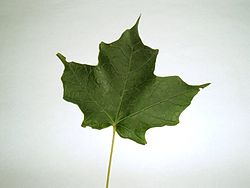AY Honors/Maple Sugar/Answer Key
1. What part of the world and time of year does the maple sugar industry function and why?
Northeastern United States and eastern Canada. This is where the maple trees that produce sugar grow and where the weather gets cold enough to produce a good flow of sap when there are warm days with the temperature above freezing and nights with the temperature below. This occurs most often in winter and early spring.
2. Explain how sweet sap is made by the Maple tree and how it is stored over the winter.
Each fall the tree produces its own supply of starch which acts like antifreeze for the roots in the winter season. As the roots take on water in early spring this results in sugar water (sap) which rises to the branches when warm weather comes to help prepare the tree for the growing season.
3. Identify the Sugar Maple tree by its bark and leaf.
The leaves are the easiest way to identify a maple tree so it is easiest to pick out the trees you are going to tap before they lose their leaves in the fall. The bark of the sugar maple is usually dark brown with vertical grooves and ridges. The easiest way to pick out maple trees without their leaves is to look for a tree that has its branches and buds in opposite position (that is in pairs on opposite sides of a branch) rather than alternate. Four native maples - sugar maple, silver maple, red maple, and black maple - all produce a sweet sap; as does the box elder (ash leaf maple). The Norway maple, a common introduced ornamental in towns, also produces sweet sap.
4. How deep into a Maple tree does one drill for best results?
The holes should be drilled about 2 1/2 inches deep including the thick bark. It should be about 7/16 or 1/2 inch in diameter and should be drilled upward at a slight angle so the sap won’t pool in the hole.
5. How long does it take for a healthy Maple tree tap's hole to heal?
It heals within a few weeks after the sap season.
6. How close to an old tap hole can a new tap hole be made?
Two to three inches.
7. How many taps can be made on a healthy Maple tree without injuring it?
a. 10 inch (25.4 cm) diameter tree
none on trees less than 10 inches. One if at least 10 inches.
b. 12 inch (30.5 cm) diameter tree
one tap on trees 10 to 18 inches.
c. 24 inch (61.0 cm) diameter tree
two taps on trees 18 to 28 inches.
d. 36 inch (91.4 cm) diameter tree
three taps on trees over 28”.
8. Tell how maple sugar is made from maple syrup.
Maple syrup is ready when the boiling temperature reaches about 7 degrees above boiling point of water (e.g. 218o F. in Michigan). If you continue boiling until the temperature reaches 30 to 33 degrees F. above the boiling point of water(e.g. 241 to 244o F. in Michigan) and then stir the syrup vigorously it will start to crystallize. At this point you put it into whatever molds or containers you wish before it hardens too much in the pan.
9. What is the ideal weather for sap to flow?
Warm sunny days above freezing and cold nights below freezing.
10. Does a Maple tree crown (limb & leaf area) affect the sap flow and sweetness?
A full well-proportioned tree in the summer will be a more healthy tree and will produce a better quality and quantity of sap the next spring.
11. On an average, how much sap is needed to produce one gallon of syrup?
30 to 40 gallons.
12. Taste pure maple syrup or maple sugar.
Yummmm!
13. Observe and explain what the following maple sugaring equipment is used for:
a. Drill
to hold the bit that makes the hole in the tree.
b. Bit
use a 7/16 or 1/2 inch bit to make the hole.
c. Spigot
inserted into tap hole (may be made of 1/2 inch dowel with a hole drilled in it). Used to hang bucket.
d. Bucket
to collect sap (plastic milk jug, etc.)
e. Bucket cover
to keep out rain and foreign material. Rain would dilute the sap and require more boiling.
f. Evaporator
used to boil sap so the excess water in the sap is driven off leaving the maple syrup or sugar.

